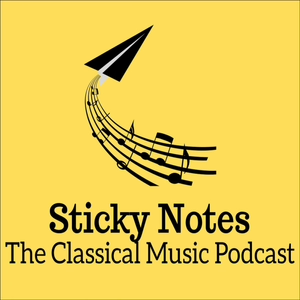
Sticky Notes: The Classical Music Podcast
Joshua Weilerstein



14 Listeners
All episodes
Best episodes
Seasons
Top 10 Sticky Notes: The Classical Music Podcast Episodes
Goodpods has curated a list of the 10 best Sticky Notes: The Classical Music Podcast episodes, ranked by the number of listens and likes each episode have garnered from our listeners. If you are listening to Sticky Notes: The Classical Music Podcast for the first time, there's no better place to start than with one of these standout episodes. If you are a fan of the show, vote for your favorite Sticky Notes: The Classical Music Podcast episode by adding your comments to the episode page.
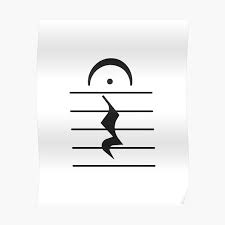
What Does Music Mean?
Sticky Notes: The Classical Music Podcast
10/19/23 • 52 min
Today is a bit of an unusual episode. Last month I was invited by the British Society of Aesthetics to address their annual conference. My task was to give a lecture on whatever topic I wanted, having to do with music. So, considering it was an Academic Philosophy conference, I chose the easiest and most straightforward topic possible - What Does Music Mean?
Obviously, this is a topic that has been interrogated from just about every different angle, and I certainly would never claim to have all the answers. But for my lecture, I decided to focus on how to find meaning in these amazing works from a performer's perspective. How do I study and learn these pieces so that I can find the meaning that I think is inside of them? What does history teach us about these pieces and can we use history to find meaning in these works? To try to answer these questions I chose three pieces to explore - Beethoven's Eroica Symphony, Barber's Adagio for Strings, and Shostakovich's 5th Symphony. After the lecture I realized it could easily be a podcast episode, so I've slightly changed a few things to make the lecture a bit more podcast-friendly. I hope you enjoy this one, and thanks to the British Society of Aesthetics for their invitation and their warm welcome!



3 Listeners
1 Comment
1
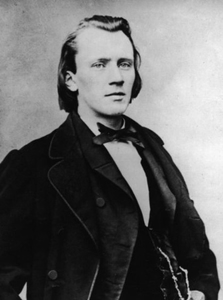
Brahms Violin Concerto
Sticky Notes: The Classical Music Podcast
10/26/23 • 50 min
Brahms’ violin concerto is one of the most difficult works for any violinist to tackle. It is as virtuosic as the hardest piece of Paganini as well as being as musically complex as a Brahms symphony. It takes most violinists years or even decades to feel comfortable with this piece, and many violinists consider it a kind of Mount Everest. Why? What makes this piece so complex, and yet so beautiful? What kind of choices do violinists make in their interpretations? For today, I'm not only going to tell you about this piece and how Brahms composed it, but I'm also going to compare 3 different recordings of the piece(Heifetz, Oistrakh, and Ferras) in order to show you the differences in interpretations between these 3 titanic violinists. We'll also talk about many of the topics we’ve covered before with Brahms; continuous development, gorgeous melodies, and that amazing Brahmsian quality of both respecting established forms while constantly subtly subverting them. Let's start the climb together and get to know this remarkable piece. Join us!



3 Listeners
2 Comments
2

Beethoven Piano Concerto No. 4
Sticky Notes: The Classical Music Podcast
06/08/23 • 59 min
Welcome to episode number 200 of Sticky Notes!!
On December 22nd, 1808, a day that would live in classical music lore forever, Ludwig Van Beethoven sat down for his very last appearance as a solo pianist to play this new piano concerto, his 4th. This performance was not only the premiere of the new piano concerto, but the premiere of two new symphonies as well, the 5th and the 6th. It featured many other new works, and the concert itself lasted nearly 4 hours, all inside of the cold and dark Theater an Der Wien with an underprepared and underrehearsed orchestra. The concert, despite featuring 3 works that would go on to be some of the most performed works in the history of classical music, was not a success. It was too long and too cold, featuring too many premieres and too much difficult music. It was criticized severely in all quarters, and Beethoven considered the concert a failure. And even that new concerto, the one that surprised so many people with its supremely gentle character, didn’t catch on quickly at all. It wasn’t until 1836 when Felix Mendelssohn, who we have to thank for so many of these situations, revived the piece. Today it is known as one of the most beloved concertos in the entire piano repertoire, partly due to the fact that it is so surprising, but not for the reasons one normally would expect. In the 4th piano concerto, Beethoven turns his entire musical brand so to speak upside down. Instead of a blazing fire, we get a gentle warmth, instead of drama, we get tenderness. And instead of virtuosity, we get a practically transcendental level of simplicity. Other than the short second movement, which does give us some of the old Beethoven fire, it is one of the most tender creations of Beethoven’s entire career. Join us to learn all about it today!


2 Listeners
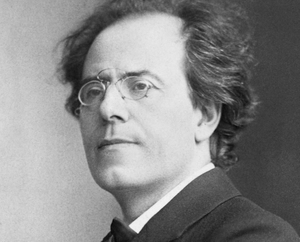
Mahler Symphony No. 2, Part 3
Sticky Notes: The Classical Music Podcast
05/14/20 • 55 min
At the end of 1893, Mahler could not find a way to end his 2nd Symphony. But the funeral of Hans Von Bulow, a conductor who Mahler worshipped even though Von Bulow hated Mahler’s music, gave Mahler what he called "the flash that all creative artists wait for." In one of the most sprawling, dramatic, and narratively based movements he would ever write, Mahler embraced a kind of universal humanism that is inspiring to this day. We'll talk about this movement and the radiant Urlicht movement that precedes it.


2 Listeners
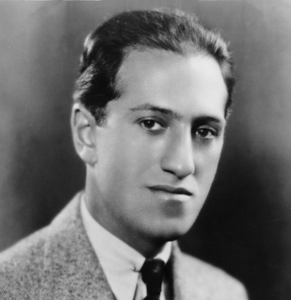
The Life and Music of George Gershwin
Sticky Notes: The Classical Music Podcast
07/28/22 • 43 min
George Gershwin’s story is like the story of so many American immigrants. His mother and father, Moishe and Rose Gershowitz, were Russian Jews who came to New York City in the 1890s looking for a better life and to escape persecution at home. Soon they became the Gershwines, and in 1898, Jacob Gershwine was born. Later on he changed his name to sound just a little bit more American, and the name George Gershwin was on its way to immortality. In just a few short years, the Gershowitz’s had become the Gershwins, and the story of George Gershwin was beginning to be written. On today’s show we’ll talk about some of Gershwin’s greatest works, including his Concerto in F, Rhapsody in Blue, and Porgy and Bess, but we’ll also talk about the collision between Classical and Pop music, a Russian Jew imbibing the purely American form of Jazz, and Gershwin’s place in the modern classical and jazz repertoire, and in America. Join us!

2 Listeners

Stravinsky: The Rite of Spring, Part 2
Sticky Notes: The Classical Music Podcast
02/09/23 • 44 min


2 Listeners
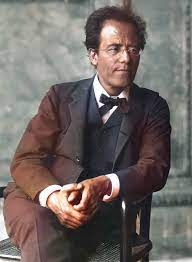
Mahler Symphony No. 4, Part 2
Sticky Notes: The Classical Music Podcast
09/21/23 • 59 min
If you haven’t listened to Part 1 of this episode about Mahler's 4th symphony, I highly recommend doing that, as every movement of this symphony builds to the "Heavenly Life" of the last movement. On Part 2, we'll be going through the 3rd and 4th movements. Mahler told his friend Natalie Bauer-Lechner that the 3rd movement of the symphony was created by ”a vision of a tombstone on which was carved an image of the departed, with folded arms, in eternal sleep.” As you can imagine based on that description, there is an unearthly beauty to the slow movement of Mahler’s 4th. Much like the Heiliger Dankgesang movement from Beethoven’s Op. 132 string quartet I talked about a couple of weeks ago, we often get the feeling in the slow movement of Mahler’s 4th that we are listening to music that is coming to us from the other side. As the slow movement comes to its end, we are introduced to the last movement, a sublime and peaceful song Mahler entitled "The Heavenly Life." This is a symphony that leaves you in a state like no other in the musical world, and so today we’ll go through that slow movement, investigating just how Mahler makes it so extraordinary, and then we’ll talk about the last movement, a movement that has divided listeners from the beginning due to its unusual text. I can’t promise we’ll find all the answers, but along the way, we’ll get to listen to some truly divine music. We’ll also get to hear Mahler himself playing - that’s right, Mahler himself! Join us!

2 Listeners
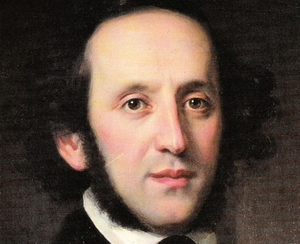
Mendelssohn Symphony No. 4, "Italian"
Sticky Notes: The Classical Music Podcast
06/23/22 • 47 min
How does a composer capture the spirit of a country, especially if it's not his native land? Mendelssohn, in his Italian Symphony, gives us one of the best examples of someone doing just that, giving us a tightly integrated, yet highly independent set of 4 snapshots from his travels all over Italy. And yet, despite the piece being called the Italian Symphony and being indelibly associated with the country, the symphony remains a relatively traditional 4 movement German classical symphony. What we hear then is a brilliant amalgamation of a symphony and a tone poem that is among the first of its kind. The symphony tells no story, has no narrative, and yet, when we finish the breathless Tarantella that ends the piece, we feel like we’ve been flicking through a photo album of Felix’s vacation, smiling (mostly) all along the way. Today we’ll talk all about how Mendelssohn builds this symphony and how each movement captures such a distinctive character, while remaining Mendelssohnian to its core - kind, warm-hearted, and full of bubbling energy. Join us!

2 Listeners
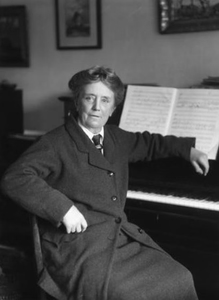
Ethel Smyth Serenade in D
Sticky Notes: The Classical Music Podcast
02/01/24 • 48 min
I’ve mentioned Ethel Smyth a few times in the past on this show. This is partly because of her music, and partly because she remains one of the most interesting people who ever lived. She was a composer of course, but she was also a conductor and an author, as well as a political activist. Specifically, she was a suffragette, fiercely advocating for the rights of women to vote in her home country of the UK. As a composer Smyth wrote dozens of works, all of which are starting to become better known as performers and administrators look to bring more music by female composers onto concert stages around the world. Smyth did not have it easy, constantly fighting for her place, battling conductors, other composers, and even her own father, all for the right to be a composer. Today, after I introduce you to a bit more of Smyth’s amazing biography, we’re going to focus on her first orchestral work, her Serenade in D Major. This is a piece that certainly doesn’t sound like a first orchestral piece, and it is full of all of the qualities that make Smyth’s music so enjoyable to listen to - lush warmth, humor, raucous intensity, and the quiet passion that runs through the music of so many great British composers. Smyth’s Serenade in D is starting to be performed more, and I’m really proud to be using my own recording of the piece for the show today, which I made with the Lausanne Chamber Orchestra in 2021. It is only the second professional recording of the piece, and the recording has just been released on Claves Records. So today, we’re going to go through this wonderful piece and also spend some more time in the wild and unpredictable world of Dame Ethel Smyth. Join us!


2 Listeners
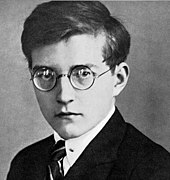
Shostakovich Symphony No. 5, Part 1
Sticky Notes: The Classical Music Podcast
12/30/21 • 52 min
Shostakovich’s life and career was so wrapped up with his relationship to the Soviet government that it is sometimes hard to appreciate that, all else aside, he was one of the great 20th century composers. His 5th symphony is the meeting point between Shostakovich's music and the political web he was often ensnared in, and it is a piece that is still being vociferously debated. This week we’re going to tell the story of the piece’s genesis, and then we’ll explore the first two movements of the symphony.


2 Listeners
Show more best episodes

Show more best episodes
FAQ
How many episodes does Sticky Notes: The Classical Music Podcast have?
Sticky Notes: The Classical Music Podcast currently has 264 episodes available.
What topics does Sticky Notes: The Classical Music Podcast cover?
The podcast is about Music, Performing, Podcasts, Piano, Arts and Performing Arts.
What is the most popular episode on Sticky Notes: The Classical Music Podcast?
The episode title 'What Does Music Mean?' is the most popular.
What is the average episode length on Sticky Notes: The Classical Music Podcast?
The average episode length on Sticky Notes: The Classical Music Podcast is 53 minutes.
How often are episodes of Sticky Notes: The Classical Music Podcast released?
Episodes of Sticky Notes: The Classical Music Podcast are typically released every 7 days.
When was the first episode of Sticky Notes: The Classical Music Podcast?
The first episode of Sticky Notes: The Classical Music Podcast was released on Mar 14, 2017.
Show more FAQ

Show more FAQ